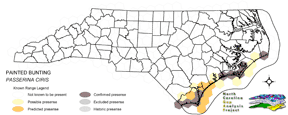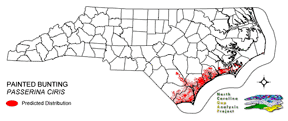
| Taxa: |
| Order: |
| Family: |
| Aves |
| Passeriformes |
| Cardinalidae |
| NatureServe Global Rank: |
| NatureServe State (NC) Rank: |
| G5 |
| S3B,SZN |
| Federal Status: |
| NC State Status: |
| --- |
| --- |


| Land Unit |
| US Fish & Wildlife Service |
| US Forest Service |
| US National Park Service |
| US Department of Defense |
| NC State Parks |
| NC University System |
| NC Wildlife Res. Com. |
| NC Forest Service |
| NC Div. of Coastal Mgmt. |
| Local Governments |
| Non-Governmental Org. |
| Other Public Lands |
| Private Lands |
| GAP Status 1-2 |
| All Protected Lands |
| Statewide |
| Hectares |
| 1,219.14 |
| 26,103.69 |
| 35,088.48 |
| 1,872.72 |
| 988.02 |
| 5,682.69 |
| 18,462.60 |
| 4,364.28 |
| 354.42 |
| 53.28 |
| 6,524.01 |
| 169.11 |
| 295,751.25 |
| 33,710.76 |
| 100,845.63 |
| 396,633.69 |
| Acres |
| 3,012.56 |
| 64,503.61 |
| 86,705.51 |
| 4,627.59 |
| 2,441.45 |
| 14,042.23 |
| 45,622.07 |
| 10,784.37 |
| 875.79 |
| 131.66 |
| 16,121.18 |
| 417.88 |
| 730,817.11 |
| 83,301.09 |
| 249,194.93 |
| 980,103.00 |
| % of Dist. on |
| Prot. Lands |
| 1.2 % |
| 25.9 % |
| 34.8 % |
| 1.9 % |
| 1.0 % |
| 5.6 % |
| 18.3 % |
| 4.3 % |
| 0.4 % |
| 6.5 % |
| 6.5 % |
| 0.2 % |
| 0.0 % |
| 33.4 % |
| ----- |
| ----- |
| % of Dist. on |
| All Lands |
| 0.3 % |
| 6.6 % |
| 8.8 % |
| 0.5 % |
| 0.2 % |
| 1.4 % |
| 4.7 % |
| 1.1 % |
| < 0.1 % |
| < 0.1 % |
| 1.6 % |
| < 0.1 % |
| 74.6 % |
| 8.5 % |
| ----- |
| ----- |
|
Fairly common and local on barrier islands and along the coast on the mainland from Marshallberg (Carteret County) south; rare farther north on the islands, and extremely rare north of Cape Hatteras (Fussell 1994). May be extending range north and inland (Potter et al. 1980). Requires extensive short herbaceous growth for foraging (Nicholson 1997) and the presence of scattered brush and trees (Ehrlich et al. 1988). Inhabits partly open areas such as overgrown fields near a forest edge (Nicholson 1997); locally it is often found in dense shrub thickets and in some residential areas (Fussell 1994). Nests in a tree, shrub, or tangle of vines, from 3 to 25 feet above the ground. Forages mostly on the ground (Ehrlich et al. 1988). NATURE SERVE GLOBAL HABITAT COMMENTS: Partly open situations with scattered brush and trees, riparian thickets and brush, weedy and shrubby areas, woodland edges, yards and gardens in the southern U.S. Nests in bush or vine tangle, usually 1-2 m up; sometimes in tree in thick Spanish moss at greater height (Harrison 1978). Males tend to return to nesting sites used in previous year (Lanyon and Thompson 1986). |
| Code | Name | Description | NC Natural Heritage Program Equivalent |
| 124 | Maritime Scrubs and Tidal Shrublands | Coastal shrubs including wax-myrtle, swamp rose, alder, yaupon, and greenbriar. | Maritime Shrubs, Salt Shrub |
| 372 | Interdune Herbaceous Wetlands | Dune swales with permanently flooded to intermittently exposed hydrology. Species composition depends on salinity and can include cut grass, spike-rush, mosquito fern, and hornwort. | Interdune Pond, Maritime Wet Grasslands |
| 371 | Maritime Grasslands | Dune grass community consisting of sea oats and beach grasses. | Dune grass, Maritime dry grassland |
| 121 | Maritime Pinelands | Loblolly forests and woodlands of the outer coastal plain. | Estuarine Fringe Loblolly Pine Forest |
| 17 | Maritime Forests and Hammocks | Maritime forests and woodlands dominated by live or sand laurel oak. Estuarine Fringe forests dominated by loblolly pine. | Coastal Fringe Evergreen Forest, Maritime Deciduous Forest, Maritime Deciduous Forest |
| 126 | Interdune Wooded Depression Swamp | Includes swamps dominated by sweetbay and swampbay or dogwood dominated forests. | Maritime Shrub Swamp, Maritime Swamp Forest |
| 173 | Coastal Plain Riverbank Shrubs | Shrub dominated riverbanks, commonly dominated by willows and/or alders. | Sand and Mud Bar |
| 63 | Coastal Plain Mesic Hardwood Forests | Beech dominated forests with white oak and northern red oak as possible co-dominants. Dry-mesic to mesic forests on slopes and small stream bottoms in the coastal plain. | Mesic Mixed Hardwood Forest, Basic Mesic Forests |
| 138 | Coastal Plain Dry to Dry-Mesic Oak Forests | Oak dominated forests of the coastal plain. Includes white oak forests with water oak or northern red oak and hickories as co-dominants. | Dry Mesic Oak Hickory Forest, Basic Oak Hickory Forest, Dry Oak Hickory Forest |
| 87 | Pocosin Woodlands and Shrublands | Includes pond pine woodland, low pocosin and high pocosin shrub dominated areas. Canebrakes and bay forests may be present. | Pond Pine Woodlands, Peatland Canebrake, Small Depression Pocosin |
| 67 | Wet Longleaf or Slash Pine Savanna | Wet flatwoods and pine savannas, typically dominated by longleaf pines, but slash or pond pines may be the dominant pines. | Wet Pine Flatwoods |
| 97 | Mesic Longleaf Pine | Longleaf pine woodlands without a major scrub oak component. Slash or loblolly pines may be present as well. | Mesic Pine Flatwoods |
| 42 | Xeric Longleaf Pine | Sandhills including a range of longleaf pine density from predominantly wiregrass, scrub oak dominated to true longleaf pine woodland. This does not include mesic or saturated flatwood types. | Xeric Sandhill Scrub, Pine/Scrub Oak Sandhill, Coastal Fringe Sandhill |
| 46 | Xeric Oak - Pine Forests | Mixed forest dominated by yellow pines with white or northern red oaks co-dominating. | Pine Oak Heath |
| 232 | Xeric Pine-Hardwood Woodlands and Forests | Mixed forest dominated by yellow pines with drier oaks including southern red, post, and chestnut oaks. | Dry Oak Hickory Forest |
| 20 | Coniferous Regeneration | Regenerating pine stands. Predominantly loblolly pine, but slash and longleaf stands occur as well. | No equivalent |
| 21 | Coniferous Cultivated Plantation (natural / planted) | Managed pine plantations, densely planted. Most planted stands are loblolly, but slash and longleaf occur as well. | No equivalent |
| 51 | Deciduous Cultivated Plantation | Planted deciduous trees. Includes sweetgum and sycamore plantations. | No equivalent |
| 36 | Successional Deciduous Forests | Regenerating deciduous trees with a shrub stature. Commonly dominated by sweetgum, tulip poplars and maples. | No equivalent |
| 180 | Agricultural Crop Fields | Farm fields used for row crops. | No equivalent |
| 205 | Agricultural Pasture/Hay and Natural Herbaceous | Farm fields used for pasture grass or hay production, as well as old fields dominated by native and exotic grasses. | No equivalent |
| 202 | Residential Urban | Includes vegetation interspersed in residential areas. Includes lawns, mixed species woodlots, and horticultural shrubs. Vegetation accounts for between 20 - 70% of the cover. | No equivalent |
|
Banks, R. C., and M. R. Browning. 1995. Comments on the status of revived old names for some North American birds. Auk 112:633-648.
Carter, M., G. Fenwick, C. Hunter, D. Pashley, D. Petit, J. Price, and J. Trapp. 1996. Watchlist 1996:For the future. Field Notes 50(3):238-240. Hagan, J.M., III, and D.W. Johnston, editors. 1992. Ecology and conservation of neotropical migrant landbirds. Smithsonian Institution Press, Washington, D.C. xiii + 609 pp. Sauer, J.R., and S. Droege. 1992. Geographical patterns in population trends of neotropical migrants in North America. Pages 26-42 in J.M. Hagan III and D.W. Johnston, editors. Ecology and conservation of neotropical migrant landbirds. Smithsonian Institu Rappole, J.H., and D.W. Warner. 1980. Ecological aspects of migrant bird behavior in Veracruz, Mexico. Pages 353-393 in A. Keast and E.S. Morton, editors. Migrant birds in the neotropics:ecology, behavior, distribution, and conservation. Smithsonian Insti Fussell, J.O. III. 1994. A birderís guide to coastal North Carolina. Chapel Hill and London: The University of North Carolina Press. Nicholson CP. 1997. Atlas of the breeding birds of Tennessee. Knoxville: University of Tennessee Press. Bent, A. C. 1968. Life histories of North American cardinals, grosbeaks, buntings, towhees, finches, sparrows, and allies. Bull. U.S. Nat. Mus. 237. Harrison, C. 1978. A field guide to the nests, eggs and nestlings of North American birds. Collins, Cleveland, Ohio. Harrison, H.H. 1979. A field guide to western birds' nests. Houghton Mifflin Company, Boston. 279 pp. Keast, A., and E. S. Morton. 1980. Migrant birds in the Neotropics; ecology, distribution, and conservation. Smithsonian Inst. Press, Washington, D.C. Potter, E. F., J. F. Parnell, and R. P. Teulings. 1980. Birds of the Carolinas. Univ. North Carolina Press, Chapel Hill. 408 pp. Terres, J.K. 1980. The Audubon Society encyclopedia of North American birds. Alfred A. Knopf, New York. American Ornithologists' Union (AOU), Committee on Classification and Nomenclature. 1983. Check-list of North American Birds. Sixth Edition. American Ornithologists' Union, Allen Press, Inc., Lawrence, Kansas. Lanyon, S. M., and C. F. Thompson. 1986. Site fidelity andhabitat quality as determinants of settlement pattern in male painted buntings. Condor 88:206-210. Ehrlich, P.R., D.S. Dobkin, and D. Wheye. 1988. The birder's handbook:a field guide to the natural history of North American birds. Simon and Shuster, Inc., New York. xxx + 785 pp. Stiles, F.G., and A.F. Skutch. 1989. A guide to the birds of Costa Rica. Comstock Publ. Associates, Cornell University Press, Ithaca, New York. 511 pp. Droege, S., and J.R. Sauer. 1990. North American Breeding Bird Survey, annual summary, 1989. U.S. Fish and Wildlife Service, Biological Report 90(8). 22 pp. Thompson, C.W. 1991. The sequence of molts and plumages in painted buntings and implications for theories of delayed plumage maturation. Condor 93:209-235. Thompson, C.W. 1991. Is the painted bunting actually two species? Problems determining species limits between allopatric populations. Condor 93:987-1000. |
For more information please contact them at:
NC-GAP Analysis Project
Dept. of Zoology, NCSU
Campus Box 7617
Raleigh, NC 27695-7617
(919) 513-2853
www.basic.ncsu.edu/ncgap